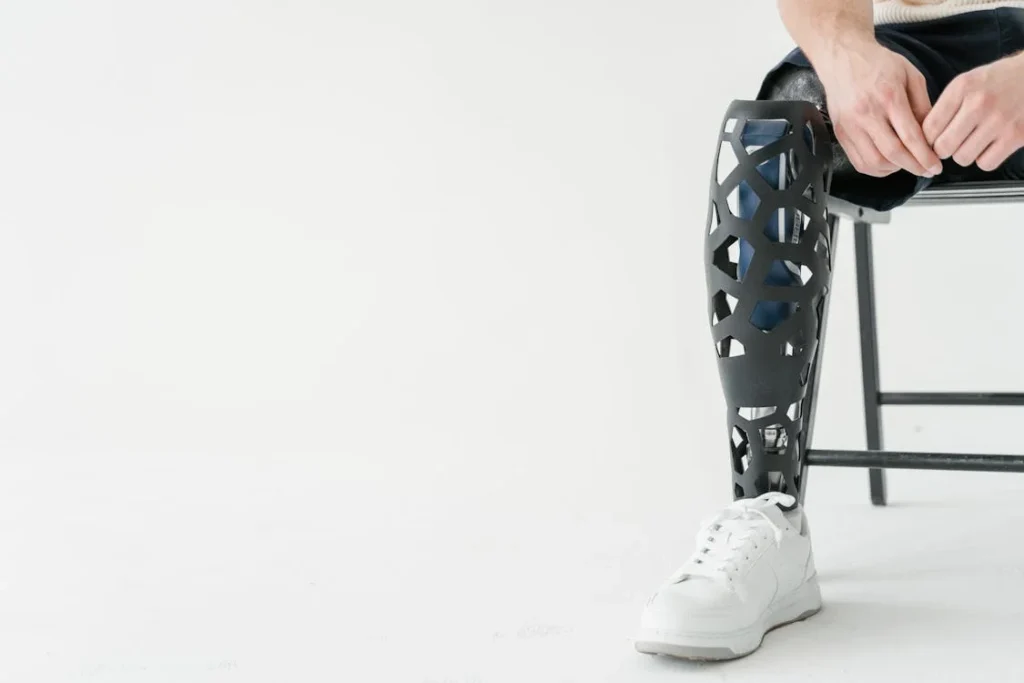Walking with a prosthetic leg isn’t just about movement — it’s about connection. It’s about how well the device understands what your body is trying to do. Until recently, prosthetic legs could only respond in simple ways. But now, thanks to smart sensors, prosthetics can actually listen. They can feel how much weight you’re putting down. They can adjust. They can give real-time feedback.
This changes everything.
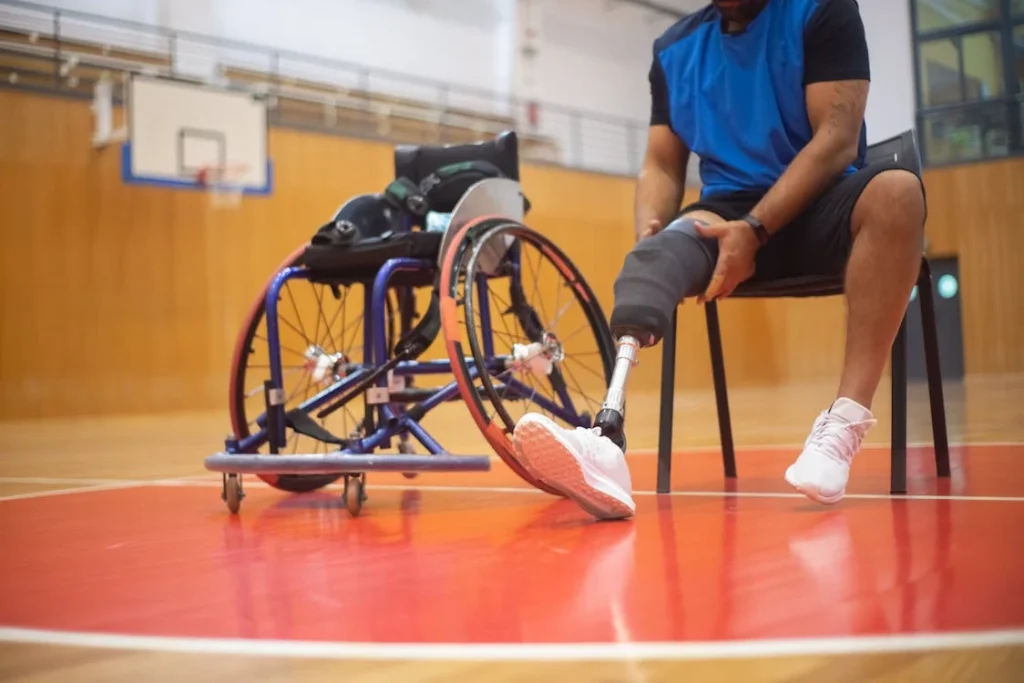
Understanding Smart Sensors in Prosthetics
Smart sensors might sound like a complicated idea, but the truth is simple: they are tiny electronic components placed inside a prosthetic leg that can feel pressure, measure movement, and send signals to tell the prosthetic how to respond.
These sensors help the leg become smarter, more aware, and more responsive to the way a person moves.
When we talk about weight load feedback, we mean the way the sensor tracks how much force is being placed on the prosthetic foot, knee, or socket at any given moment.
This information is crucial because it tells the device — and sometimes the user — how their body is moving and whether the prosthetic is working the way it should.
Let’s explore how these sensors work, and why they’re making such a big impact in the field of prosthetics.
How Smart Sensors Work Inside a Prosthetic
Inside a modern prosthetic, smart sensors are often placed in key areas that bear weight or control motion — like the heel, sole, socket, or even the artificial knee.
These sensors are designed to measure things like pressure, angle, motion, and speed. Some sensors can also detect temperature and vibration, but for weight load feedback, pressure sensors are the most important.
When a user steps onto their prosthetic foot, the pressure sensor records the exact force at that moment. It senses how much weight is being applied and how quickly it’s changing.
That data is then sent to a microcontroller — a small computer chip inside the prosthetic. The chip processes the data and decides how the prosthetic should respond.
For example, if the sensor feels that the heel is bearing too much weight too quickly, the prosthetic might adjust to make the step more stable.
If it notices uneven pressure across the socket, it may alert the user or the rehab team to look at socket fit. Some high-end systems can even change how stiff the foot is or how fast the knee swings based on sensor input.
This happens in real time — meaning as you walk, the system is thinking, sensing, and adjusting with every single step. This is why smart sensors are such a game changer.
Why Weight Load Feedback Is So Important
When someone uses a prosthetic leg, one of the most difficult things to relearn is how to shift their body weight correctly. If the user doesn’t put enough weight on the prosthetic leg, walking becomes unbalanced.
If they put too much weight in the wrong spot — say, the toes instead of the heel — the movement becomes unstable. Over time, this can lead to falls, pain, or wear and tear on the prosthetic itself.
Smart sensors remove the guesswork. They tell the system where the weight is going and how it’s changing. This allows for smoother walking, better balance, and fewer mistakes.
Even more importantly, it gives the user real feedback they can use to improve their walking patterns.
This is especially useful during the early stages of rehabilitation. When someone first starts walking with a prosthetic, their body doesn’t always move the way they expect it to.
The sensors help both the user and the therapist understand what’s happening during each step. It’s like having a coach inside your leg, gently guiding your movements and helping you learn faster.
Adapting to the User’s Style and Surface
Another benefit of smart sensors is adaptability. Everyone walks a little differently. Some people walk fast, some slow. Some people have short strides, others long.
Some need to walk on stairs, ramps, or uneven roads. A prosthetic with smart sensors doesn’t need to be told how to handle these differences — it figures it out by feeling how the weight shifts.
Let’s say someone starts walking uphill. The pressure on the toe area increases, and the angle of the step changes. The sensor picks that up and sends a message to the knee or ankle module to adjust stiffness or motion speed.
The same thing happens when walking downstairs, on gravel, or even across wet tiles. The prosthetic learns how the body is reacting to the surface, and adapts in real time.
This isn’t science fiction. These systems are already in use around the world, and at Robobionics, we’re integrating similar feedback technologies into our development process.
For our users across India, where the walking environments are so varied — from busy streets to hilly villages — this real-time feedback helps them move with more confidence and less stress.
Enhancing Safety and Preventing Injuries
One of the most powerful uses of weight load feedback is preventing falls and injuries. Many accidents happen because of poor weight transfer or sudden missteps. The person might not even realize they’re walking unevenly until they slip or stumble.
Smart sensors reduce that risk by acting as an early warning system. If the system detects that the user is putting too much pressure on the heel or leaning awkwardly, it can respond instantly.
Some devices gently correct the movement by adjusting joint resistance. Others may buzz or send an alert through a connected app to let the user know to pause or correct their posture.
This kind of real-time feedback is especially helpful for older users, or for those recovering from additional health issues like stroke, diabetes, or nerve damage. It gives them a safer walking experience and more independence.
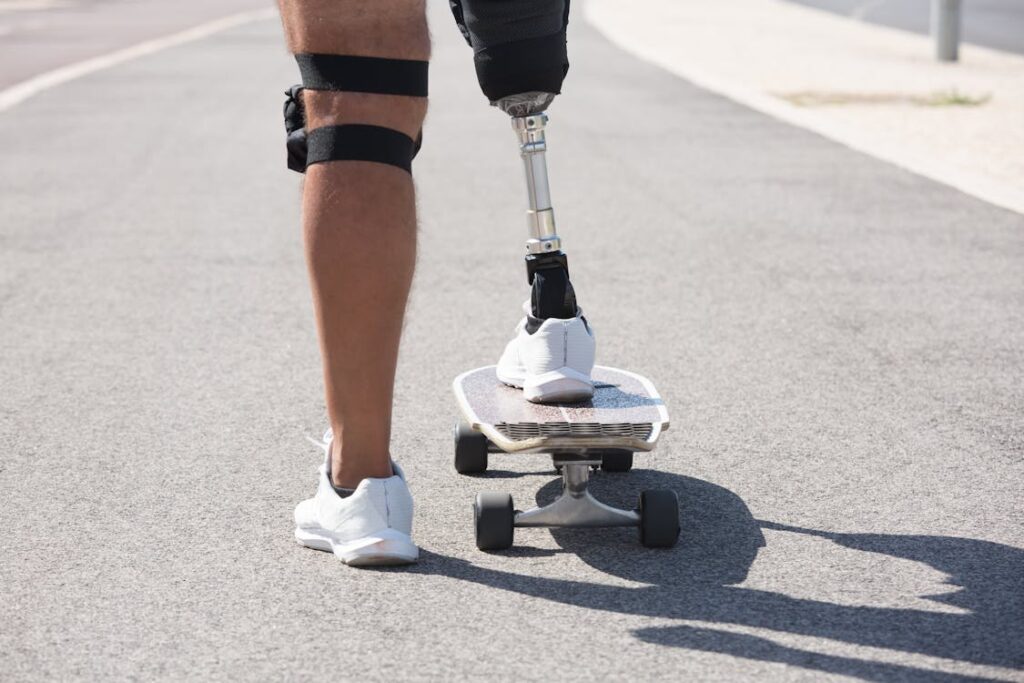
Real-Time Feedback in Daily Life
Now that we understand how smart sensors work and why they matter, let’s look at how they improve everyday life for prosthetic users. These benefits go beyond the clinic. They affect how someone walks to the store, climbs stairs at home, or plays with their kids in the park.
Making Movement Feel Natural
One of the hardest things after an amputation is getting used to a new rhythm of movement. Walking may feel stiff, unbalanced, or even a bit scary.
Many people tend to favor their healthy leg, which causes further problems like muscle fatigue or lower back pain.
Smart sensors help change that by improving symmetry. When sensors measure how much weight is on each foot, they can adjust the timing of steps to make the walk smoother.
If the system sees that one step is shorter than the other or that pressure is uneven, it can help guide the prosthetic to respond better.
The result is more natural movement. Instead of thinking about every single step, the user can begin to trust the device to work with their body. That trust leads to better balance, more fluid motion, and less mental strain during walking.
This benefit is especially clear for transfemoral (above-knee) users. With no natural knee joint, every step relies on controlled movement of a mechanical or robotic knee.
Sensors help this process by giving precise feedback on when to bend the knee, how quickly to extend it, and how much resistance is needed.
Supporting Physical Therapy and Rehab
Smart prosthetics are also a great tool in rehabilitation. When someone starts using a new prosthetic, there’s a lot to learn.
Therapists work hard to teach weight transfer, posture, and step timing, but they can’t see inside the user’s body. That’s where real-time data becomes helpful.
Some smart prosthetic systems come with companion apps or dashboards. These show the user and the therapist detailed information about how each step is performed — where pressure was applied, whether weight was evenly distributed, and if the gait was balanced.
Instead of guessing, the rehab team can now make decisions based on real numbers. They can spot problems early, like a misaligned socket or poor muscle control, and adjust the training plan.
The user also benefits from seeing their progress in numbers and graphs, which can be motivating.
At Robobionics, we believe rehab should be smart, simple, and supportive. That’s why we’re exploring ways to bring affordable, sensor-enabled feedback tools into our rehab programs across India. This technology, paired with expert care, can accelerate recovery and improve long-term outcomes.
Boosting Confidence and Emotional Wellbeing
It’s easy to talk about balance and motion, but there’s another side of using a prosthetic — the emotional part. Many users feel self-conscious or unsure about how they walk.
They worry about falling or looking different. These feelings can limit how much they go out, try new things, or engage socially.
Smart sensors help in a quiet but powerful way. When a prosthetic responds smoothly to each step, the user starts to forget about the device.
They stop checking the ground constantly. They stop bracing themselves at every corner. Instead, they start moving with more ease and freedom.
This new sense of control improves confidence. It allows people to rejoin life without hesitation — whether that’s walking to the office, shopping in a market, or taking a bus across town.
Every time the sensors adjust a step or give feedback that prevents a stumble, they are building trust between the user and the device.
We’ve seen this time and again with our users. Some of them were scared to walk without support just a few weeks after surgery. With guided training and the right technology, they now walk independently. They stand taller, smile more, and say yes to more experiences. That’s the power of real-time feedback.
Supporting Long-Term Health
A prosthetic leg doesn’t just support walking — it supports the whole body. If the user walks unevenly, the extra strain affects the hips, spine, and even the other leg. Over time, this can lead to chronic pain, arthritis, and joint damage.
By helping users walk more symmetrically and distribute weight properly, smart sensors help prevent these long-term issues. They encourage better posture, more equal use of both sides of the body, and fewer harmful habits.
Sensors can also detect small changes in walking patterns. If a user begins limping more than usual or shifting their weight to one side, it may be an early sign of a problem.
Perhaps the socket fit has changed, or the residual limb is irritated. By spotting these changes early, users can get help before things get worse.
This kind of early intervention is especially important in India, where access to follow-up care may be limited in remote areas. By using smart sensors to track and alert users about their walking health, we can make prosthetic care more proactive and less reactive.

The Technology Behind Smart Sensors: Simple Yet Powerful
While smart sensors might seem like advanced tech, they are based on simple science. These small components are designed to read forces, angles, and movements. But it’s how they use that information that makes them powerful.
Types of Sensors Commonly Used
There are a few main types of sensors used in prosthetics, each doing a specific job. Pressure sensors measure how much force is being applied to a part of the prosthetic — like the heel, toe, or socket. These are essential for understanding weight load and how a user is stepping.
Accelerometers and gyroscopes track movement and orientation. They can detect how fast the leg is swinging, whether it’s bending or rotating, and in which direction.
These help the prosthetic understand motion and adjust its behavior during each step.
Strain gauges measure how much the material of the prosthetic is flexing or stretching. This helps engineers understand stress points in the design, but it can also be used to adjust stiffness or shock absorption in real time.
Force-sensitive resistors and piezoelectric elements are also used in advanced limbs to detect minute changes in pressure and force. These help create a more responsive and lifelike experience.
Together, these sensors send constant streams of data to a processor — a small computer embedded in the prosthetic.
The processor makes decisions instantly, such as whether to lock the knee, adjust the foot angle, or alert the user to a problem.
Smart Systems That Talk to Each Other
Modern prosthetic devices are no longer standalone components. In a smart system, the sensors, processor, and mechanical parts all work together. They share information, adjust settings, and learn from the user’s habits.
Some systems even use machine learning — a form of artificial intelligence — to improve over time. The more you walk, the more the prosthetic understands how you walk.
It begins to recognize your rhythm, preferred speed, and typical pressure patterns. Then it uses that knowledge to make better decisions automatically.
For example, if the prosthetic senses that you often slow down before turning left, it may prepare in advance by adjusting the foot angle or joint stiffness. This kind of predictive support makes walking feel less robotic and more human.
Smart systems can also connect to external devices. Some prosthetics send data to a mobile app, where users and therapists can monitor walking stats, receive alerts, or even change settings like step length or joint resistance. This puts control back in the user’s hands.
At Robobionics, we are committed to making these technologies more accessible. While many of these systems are found in expensive, imported devices, we are working toward affordable, India-ready alternatives that still deliver high performance and real-time feedback.
Challenges in Sensor Integration
Even with all the benefits, building smart sensors into prosthetics isn’t easy. There are a few technical and user challenges that manufacturers and clinicians must overcome.
First, the sensors must be durable. They need to withstand pressure, dirt, sweat, and constant motion. Since prosthetic users often walk in all kinds of environments — from city sidewalks to rural paths — the sensors must work reliably in heat, humidity, and dust.
Second, they need to be small and light. Any extra weight makes walking harder. If the electronics are bulky or interfere with movement, they can reduce comfort and usability.
Third, the sensors and software must be easy to use. Users shouldn’t need to be engineers to benefit from the technology. The system must work quietly in the background, supporting movement without needing constant adjustment.
Finally, there’s the issue of cost. Many smart prosthetic systems today are out of reach for average users in India. They require not just the device but also ongoing software support, updates, and compatible smartphones or computers. At Robobionics, we are addressing this challenge by developing simpler, more cost-effective solutions that still offer real-time feedback and safety features.
The Future of Sensor-Driven Prosthetics
The future of smart prosthetics is bright. As sensors become smaller, more accurate, and more affordable, we will see even more personalized and adaptive prosthetic legs. These legs will not only respond to movement but anticipate it. They will not just react to pressure, but learn from it.
Imagine a prosthetic that reminds you to correct your posture when it senses you leaning too far forward.
Or one that warns you if your gait pattern changes suddenly — possibly due to fatigue or early signs of injury. These tools will not only help with walking but also with long-term health and well-being.
We also see a future where prosthetics are more connected. A user in a remote village could walk with a smart limb that sends data to a clinic in a nearby city.
Therapists could guide the user in real-time, offering support from miles away. This kind of remote care, powered by sensor technology, can transform lives, especially in regions with limited access to healthcare.
At Robobionics, we are investing in this future. Our vision is to blend human care with smart technology — giving every user the tools they need to walk confidently, safely, and with dignity.

Gamified Rehabilitation Powered by Sensor Feedback
Rehabilitation used to be simple but repetitive — balance drills, walking practice, strength training, and therapy sessions. These are still essential, but now, with smart sensors embedded in prosthetics, we can make this process smarter, more engaging, and far more effective.
One of the most exciting developments in this space is gamified rehab, which uses technology and real-time feedback to turn boring exercises into interactive experiences.
Why Gamification Matters in Recovery
After an amputation, learning to use a prosthetic leg takes time. It can be frustrating, tiring, and emotionally draining. Many users — especially children and older adults — lose motivation after the first few weeks of rehab. That’s where gamification makes a big difference.
Gamified rehab adds a layer of play and purpose. Users perform the same important movements — shifting weight, balancing, walking, climbing — but now, those actions are part of a game.
A step becomes a score. A balance drill becomes a challenge. A walk across the room becomes a level to unlock.
This approach makes training more fun, which keeps users consistent. And consistency is the most important factor in recovery. When users enjoy the process, they stick with it — and when they stick with it, they improve faster.
How Smart Sensors Make Games Smarter
For gamified rehab to work well, the system needs to know what the user is doing in real time. That’s where smart sensors come in. The same sensors that track weight load and pressure can be used to control games and training apps.
For example, a pressure sensor in the prosthetic foot can detect if the user is putting enough weight down during an exercise.
If they aren’t, the game might pause or flash a warning. If they shift correctly, they earn points or trigger an action on screen.
This instant feedback helps users correct their movements while staying engaged. It also allows therapists and caregivers to monitor progress remotely.
They can see how often the user practices, how accurate their movements are, and where they’re struggling — all based on data from the sensors.
At Robobionics, we’ve integrated this idea into our home-based rehab model. Our users — especially children — enjoy simple rehab games they can play at home using their prosthetic limb.
These games are not just for fun. They’re built around clinical goals: proper weight transfer, muscle engagement, and posture training. And the smart sensors ensure that every move counts.
Personalized Rehab Through Sensor Data
One major strength of combining gamified rehab with smart sensors is personalization. Everyone recovers at their own pace.
Some people need more help with balance, others with weight shift or joint movement. By collecting real-time data, the rehab system can adjust the difficulty of the games based on the user’s performance.
If someone is doing well, the system can make the next challenge slightly harder — maybe by asking for more precise weight shifts or quicker reaction times. If someone is struggling, the system can slow down and focus on fundamentals.
This kind of personalized rehab ensures users aren’t overwhelmed, bored, or stuck. It meets them where they are and grows with them. Over time, this creates real, lasting improvement in mobility and confidence.
Beyond the Clinic: Expanding Access to Quality Rehab
One of the biggest challenges in India is access to regular, high-quality rehabilitation. Many users live far from physical therapy centers. Some can’t afford frequent visits. This gap often delays recovery and increases dependency.
Gamified rehab with smart sensor support brings professional-level guidance into the home. All that’s needed is a prosthetic with embedded sensors and a mobile device.
Users can train daily, monitor their progress, and even connect with therapists online for feedback and adjustments.
For rural users, children, and elderly individuals, this is a game changer. It removes travel, cost, and time barriers — without compromising on quality. It also gives users a greater sense of control over their recovery, which improves motivation and emotional well-being.
Building Habit and Ownership
Rehab isn’t just about getting strong again — it’s about making movement a part of life again.
When users interact with their prosthetic through play, challenge, and real-time feedback, they begin to see it not just as a tool, but as a partner.
Gamified rehab builds habit. And with sensors tracking weight transfer and progress, every session becomes part of a larger story.
One where the user is the main character — not a patient, but a player, a learner, and eventually, a confident mover in their own world.
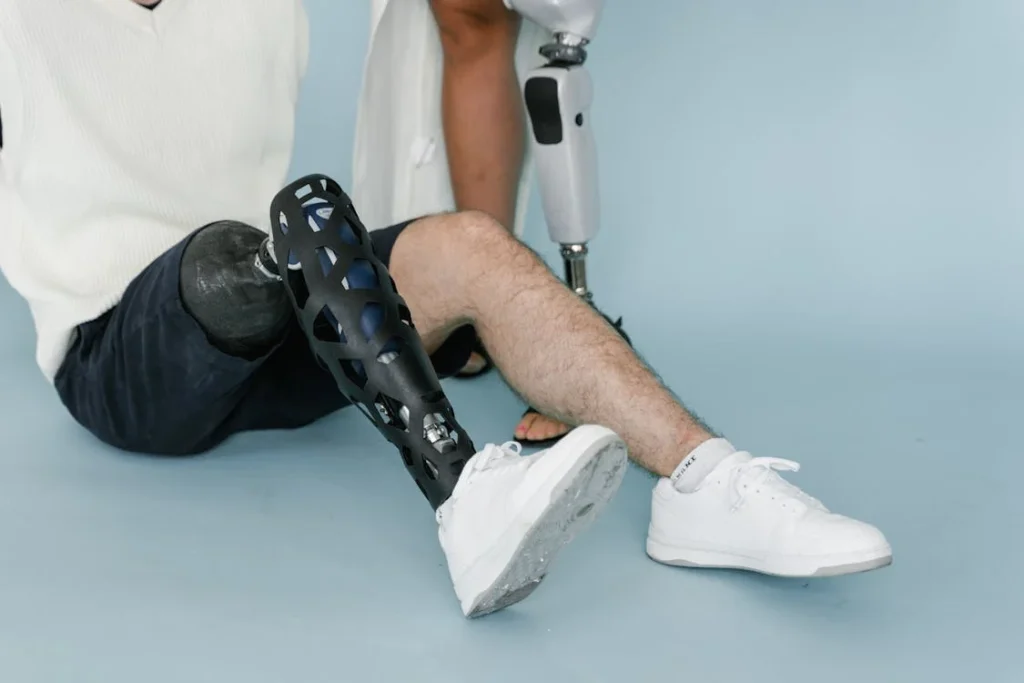
Designing Smarter Prosthetics: How Real-Time Sensor Feedback Shapes Customization
Smart sensors don’t just help users — they’re also transforming how prosthetic limbs are built and fitted. Traditional prosthetic design has always relied on a mix of physical measurements, clinical judgment, and user feedback. While that process has helped thousands of people walk again, it also has limitations.
Fit issues, pressure sores, gait problems, and discomfort can go unnoticed until they cause bigger complications.
Now, with smart sensors providing real-time data on how each user applies weight to their prosthetic, we’re entering a new era of data-driven prosthetic design.
At Robobionics, we’re actively using this insight to create limbs that aren’t just built to fit — they’re built to respond.
Moving From Static Fit to Dynamic Fit
The traditional socket fitting process starts with casting the residual limb, followed by trials, adjustments, and user feedback. This relies heavily on what a person feels and says.
But what about what they can’t feel or express? What if pressure is building up in one area of the socket that the user doesn’t notice until it causes skin damage?
Smart sensors inside the socket can now measure pressure in real time. If one side bears more weight consistently, that’s a sign that the alignment may be off — even if the user feels “fine” at first.
With this data, clinicians and engineers can reshape the socket, adjust the angle of the limb, or change the suspension system for a more even distribution of force.
This approach — known as dynamic socket fitting — results in fewer adjustments over time, more comfort from the start, and reduced risk of long-term limb injury.
It’s a shift from “let’s see how it feels” to “let’s see what the data says,” making prosthetic care both more precise and more proactive.
Faster Innovation Through Real-World Use Data
One of the most powerful things about sensor feedback is that it doesn’t end at the fitting bench. When a user walks with a smart prosthetic, the system collects valuable information about how the device behaves in the real world — not just in a clinic.
It tracks how the foot responds to hills, how the socket handles long-distance walking, or how the knee performs during sudden stops.
This kind of real-world performance data is a goldmine for engineers. It helps identify design flaws, improve materials, and refine control systems — all based on how people actually live and move.
At Robobionics, we use this feedback to enhance each new generation of our prosthetics. Instead of relying solely on lab tests or trial runs, we base design changes on the lived experiences of users across different age groups, terrains, and activity levels.
This means our devices don’t just improve over time — they evolve in response to real human needs.
Tailoring Movement to the Individual
Not all users move the same way. Some take short, quick steps. Others walk slowly but with a longer stride. Some users apply more weight at the toe, others on the heel.
Age, fitness level, amputation level, and even confidence can shape a person’s gait pattern.
Smart sensors allow us to learn and respond to these individual styles. Instead of building a “one-size-fits-all” movement system, we can personalize the joint response, foot dynamics, and socket adjustments to match each user’s pattern.
For instance, if a user applies more force on the lateral (outer) side of the prosthetic foot, we might adjust the stiffness or cushioning on that side.
If another user struggles with consistent step timing, the smart knee might be tuned to slow down slightly to give them more control.
This personalized fine-tuning is not something that could be done effectively before smart sensors. Now, it’s not only possible — it’s becoming standard practice in advanced prosthetic care.
Reducing Maintenance Through Predictive Design
One of the hidden costs of prosthetic use is maintenance. As parts wear out or shift, users might experience discomfort, instability, or even mechanical failure. These issues often go unnoticed until they become urgent.
With sensors tracking weight load patterns and usage frequency, prosthetic systems can now predict wear and tear before it becomes a problem.
If a joint is absorbing higher forces than expected, the system might suggest a check-up. If a foot module is showing signs of uneven pressure, it could signal the need for realignment.
This predictive approach helps users avoid downtime and costly repairs. It also helps manufacturers build parts that last longer, because they understand exactly how and where stress occurs during daily use.
At Robobionics, we’re incorporating predictive design into our workflow — using sensor data to build smarter, stronger, more reliable limbs that adapt to our users’ lives, not the other way around.
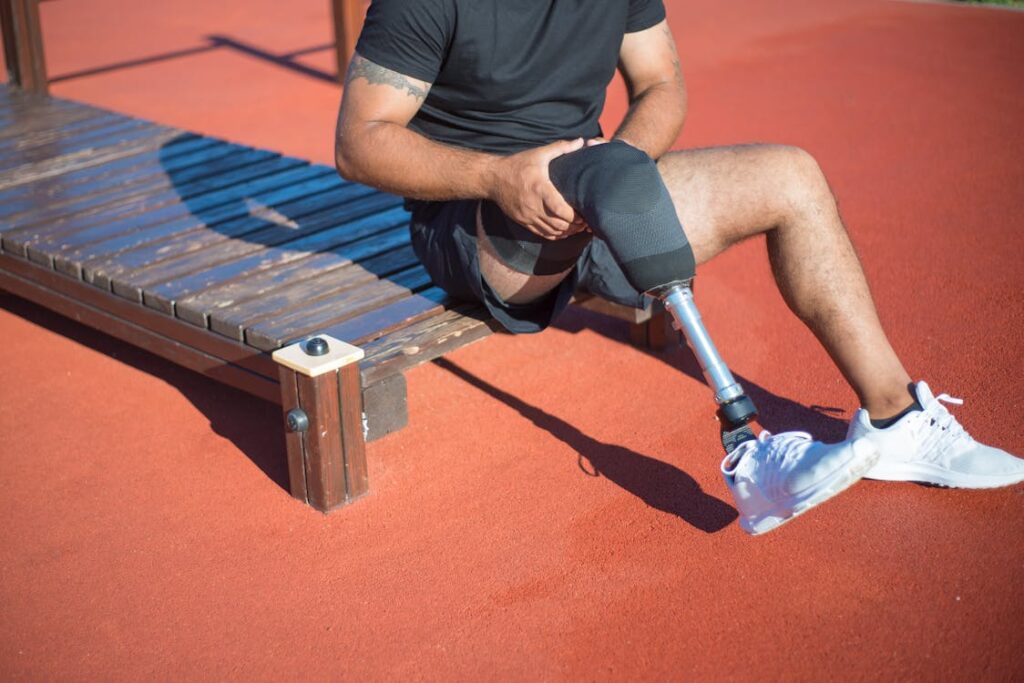
Bridging Mind and Machine: Hybrid Control Through Smart Sensors
One of the most exciting advances in prosthetic technology isn’t just about how the leg moves — it’s about how well it understands the user’s intent.
With smart sensors collecting data in real time, we’re moving closer to a world where prosthetics don’t just respond to movement — they predict it. This evolving interface between human thought and machine action is known as hybrid control, and it’s changing the way we think about mobility.
The Gap Between Intention and Action
When you move a natural leg, your brain sends electrical signals through your nerves to your muscles. Those muscles contract and pull on bones, making you walk, run, or stand. It all happens instantly, and you hardly think about it.
After an amputation, that direct path between brain and limb is broken. You might still want to take a step — your brain still sends the signal — but the pathway to the muscles and joints is no longer there. That’s where smart prosthetics step in.
But here’s the catch: traditional prosthetics don’t “know” what the user is trying to do. They simply respond to pressure or position.
This delay can lead to unnatural motion, especially for transfemoral users who rely on mechanical knees. That’s why bridging this communication gap between human intention and mechanical execution is so important.
How Smart Sensors Help Decode Intent
Smart sensors are now helping fill that gap. By measuring pressure, motion, and timing in real time, these sensors can begin to interpret the user’s movement intention based on past behavior.
For example, if a user leans slightly forward and places pressure on their toe, the prosthetic can learn that this usually means “prepare to walk.” The leg can unlock the knee, stabilize the ankle, and move in anticipation — rather than just reacting.
Over time, the prosthetic learns patterns unique to the individual. It starts to understand when they’re about to stand, shift weight, or change pace — not just based on foot pressure, but also on how fast and in what direction pressure builds.
In a sense, smart sensors act like interpreters, translating subtle body cues into mechanical decisions. The prosthetic isn’t just a tool anymore — it becomes a thinking partner that walks with the user, not behind them.
Combining Sensor Data with Neural Signals
In cutting-edge research and early clinical trials, some systems are going a step further by combining sensor data with myoelectric signals — electrical activity from the muscles that remain after amputation.
These myoelectric sensors are placed on the skin or implanted into the muscle. They detect tiny changes in voltage when the user tries to move their limb.
When combined with foot pressure and motion data from smart sensors, the system creates a more complete picture of what the user wants to do — not just what they are doing.
This hybrid control model is showing promising results. It allows for faster reaction times, more intuitive motion, and better sync between the brain and the device. Users report that the prosthetic “feels more alive” — not because it’s robotic, but because it’s aligned with their intention.
At Robobionics, we’re closely following these advancements, with a vision to eventually integrate lightweight, affordable versions of hybrid systems into mainstream prosthetics for users in India.
The future we see is one where prosthetic limbs are not controlled by machines alone — but by the person wearing them, with full support from intelligent technology.
Real-Life Impacts of Hybrid Control
Imagine walking across a busy street and needing to change direction quickly. With a basic prosthetic, you have to think through each step: lift, rotate, stabilize, step.
But with a hybrid-controlled leg, the prosthetic senses your shift in weight and adjusts automatically. It doesn’t wait for you to stumble. It moves with you.
Or consider climbing stairs. With traditional devices, users often have to take stairs one step at a time, leading with the sound leg.
But hybrid systems, fed by real-time sensor input and intent signals, can learn to support reciprocal stair climbing — one foot per step, like natural walking.
These improvements go beyond convenience. They increase safety, reduce mental effort, and bring back a feeling many users miss: spontaneity. The ability to act without pausing.
The ability to move without thinking too much about how to move.
This level of responsiveness brings prosthetics closer to being true extensions of the body, not just mechanical replacements.
Conclusion
Smart sensors are quietly transforming prosthetics from passive tools into intelligent partners. By providing real-time feedback on weight load, they help users walk more naturally, stay safer, and feel more connected to their bodies. These sensors not only improve day-to-day mobility but also guide better rehab, smarter customization, and more responsive design.
At Robobionics, we believe prosthetics should evolve with the person — learning, adapting, and empowering movement at every step. Whether it’s through gamified rehab, predictive maintenance, or hybrid control systems, sensor-driven technology is helping people reclaim their independence in ways never imagined before.
As we look ahead, one thing is clear: prosthetics aren’t just getting smarter. They’re becoming more human.
Ready to experience smart prosthetics built for real life? Book a free Grippy™ demo and see how sensor-integrated design can change the way you move.



